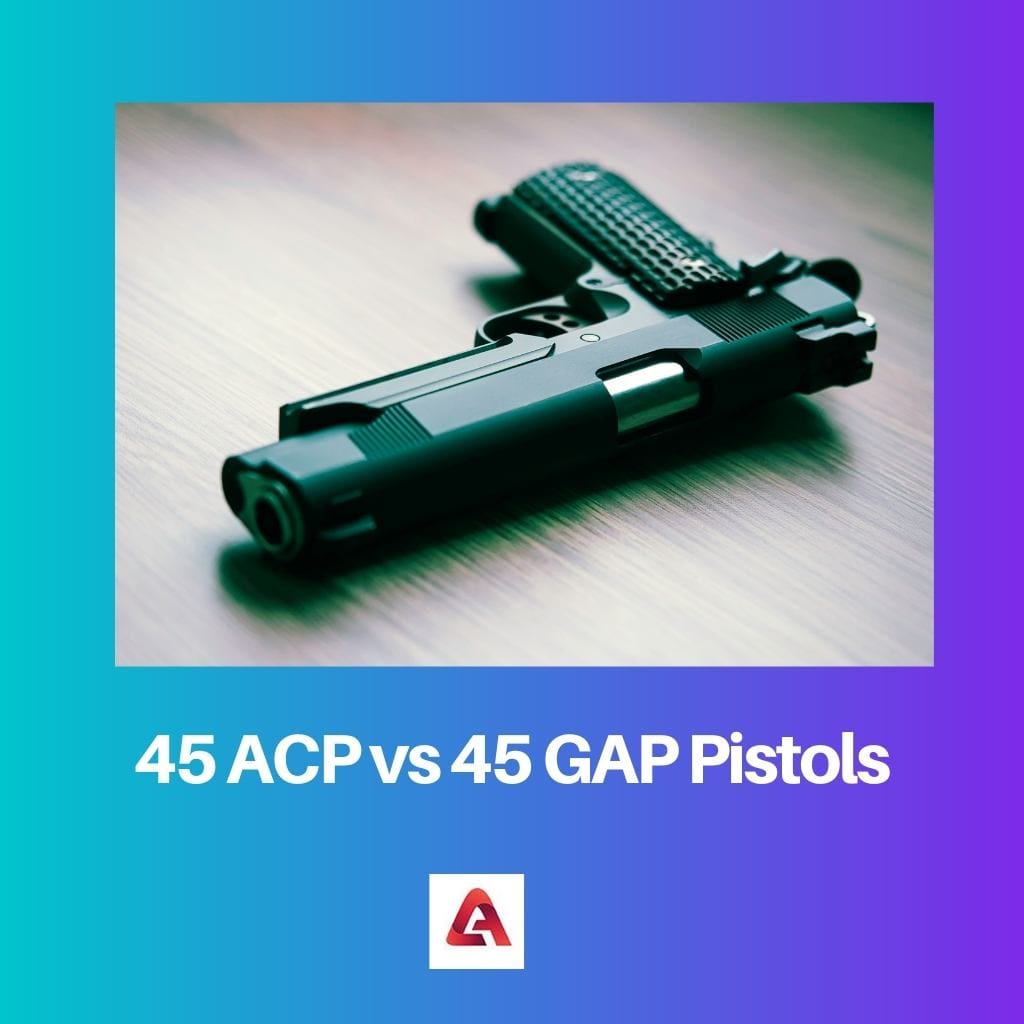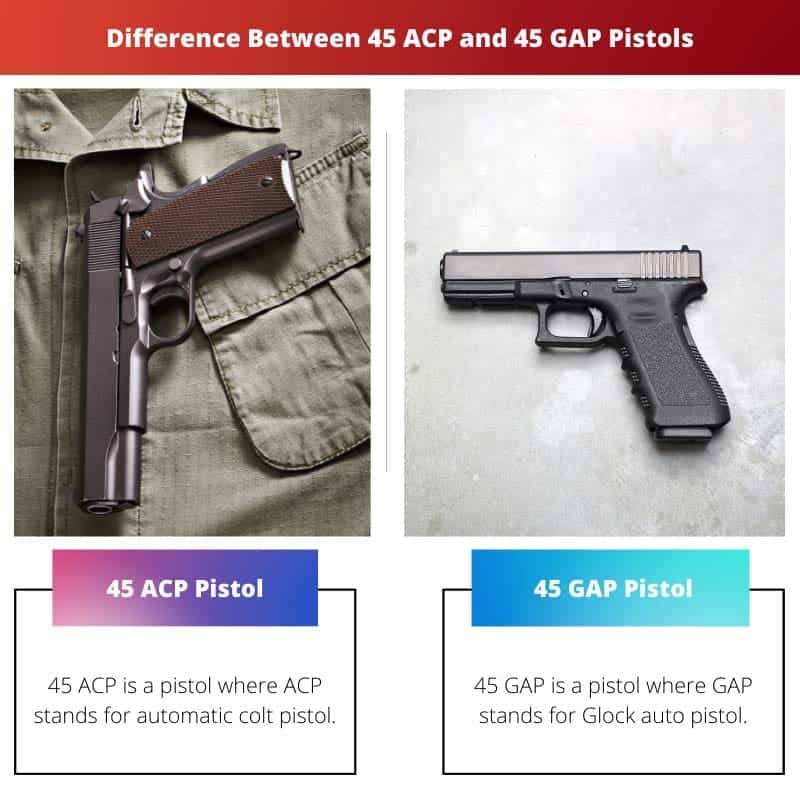ACP, which stands for Automatic Colt Pistol, refers to a family of cartridges developed by Colt for their semi-automatic pistols. It includes popular calibers like .45 ACP (Automatic Colt Pistol). 45 GAP (Glock Automatic Pistol) is a newer cartridge introduced by Glock to offer similar ballistics to .45 ACP but in a shorter cartridge, allowing for more compact pistol designs.
Key Takeaways
- The .45 ACP has been used for over a century, is more widely available, and has more ammunition options than the newer .45 GAP.
- The .45 GAP is a more compact cartridge and allows for a smaller grip size on pistols, making it more suitable for concealed carry.
- The .45 ACP has higher muzzle energy and greater stopping power than the .45 GAP.
45 ACP vs. 45 GAP Pistols
45 ACP cartridges are available and come in various loads, making them suitable for everything from self-defense to target shooting.45 GAP (Glock Automatic Pistol) is a recent cartridge designed for Glock pistols. It has a shorter length and a higher pressure than 45 ACP.

45 ACP is a pistol where ACP stands for automatic Colt pistol. It originated in n the year 1904 by John Moses Browning.
It has a 230-grain bullet weight and is quite popular among large-caliber sports shooters and the army. It provides excellent accuracy and power when used against human targets and operates at 21.000 psi chamber pressure.
The diameter and length of 45 ACP are quite significant.
45 GAP is a pistol where GAP stands for Glock auto pistol and is designed by Ernest Durham. It is also known as the 45 Glock. It has a slightly short diameter and length.
It has a maximum bullet weight of 200 grains and is operated at a pressure of 23,000 psi. Its total length is 27.22 mm.
Four state law enforcement agencies have accepted the 45 GAP as a replacement for the service gun, thus making it a very popular pistol among other manufacturers,
Comparison Table
| Feature | .45 ACP | .45 GAP |
|---|---|---|
| Year Introduced | 1904 | 2000 |
| Designer | John Browning | Glock |
| Purpose | Military and self-defense | Self-defense and concealed carry |
| Overall Cartridge Length (in) | 0.900 | 0.760 |
| Bullet Diameter (in) | 0.451 | 0.451 |
| Typical Bullet Weight (gr) | 230 | 185-200 |
| Muzzle Velocity (ft/s) (4″ barrel) | 850-900 | 950-1000 |
| Muzzle Energy (ft-lbs) (4″ barrel) | 400-450 | 400-450 |
| Maximum Average Pressure (PSI) | 21,000 | 23,000 |
| Magazine Capacity (typical) | 7-8 | 10-13 |
| Firearm Size | Larger frame size | Smaller frame size similar to 9mm or .40 S&W |
| Popularity | More popular, wider variety of firearms and ammunition | Less popular, limited availability of firearms and ammunition |
| Recoil | More pronounced | Less pronounced |
What is 45 ACP?
Introduction to the .45 ACP Pistol
The .45 ACP pistol, also known as the .45 Auto, .45 Automatic Colt Pistol, or simply .45, is a popular handgun cartridge designed by John Browning in 1905. It was initially developed for use in the Colt M1911 semi-automatic pistol, which became the standard-issue sidearm for the United States Armed Forces from 1911 until 1985.
Characteristics of the .45 ACP Cartridge
The .45 ACP cartridge is renowned for its stopping power and effectiveness, making it a favored choice for self-defense and law enforcement applications. It features a relatively large, heavy bullet with a diameter of .451 inches (11.45 mm), weighing between 185 to 230 grains (11.99 to 14.91 grams).
Ballistics and Performance
The .45 ACP cartridge fires at subsonic velocities, providing excellent energy transfer upon impact. Its moderate velocity combined with a heavy bullet results in impressive terminal ballistics, capable of delivering substantial kinetic energy to the target.
Firearms Chambered in .45 ACP
Numerous firearms have been chambered for the .45 ACP cartridge, including iconic handguns like the Colt M1911, Smith & Wesson M&P45, Glock 21, and various models from Springfield Armory, Heckler & Koch, and Sig Sauer. These firearms come in various configurations, including full-size, compact, and subcompact, catering to a wide range of preferences and requirements.
Uses and Applications
The .45 ACP cartridge is favored by many shooters for self-defense, home defense, and competitive shooting sports such as USPSA (United States Practical Shooting Association) and IDPA (International Defensive Pistol Association) matches. Its reputation for stopping power and reliability has made it a staple among firearm enthusiasts worldwide.

What is 45 GAP?
Introduction to the .45 GAP Cartridge
The .45 GAP (Glock Automatic Pistol) is a relatively recent addition to the realm of handgun cartridges, developed by Glock in 2003. It was designed as a shorter version of the .45 ACP cartridge, offering similar ballistic performance in a more compact package.
Characteristics of the .45 GAP Cartridge
The .45 GAP cartridge shares similarities with its predecessor, the .45 ACP, but with a shorter overall length. It features a bullet diameter of .451 inches (11.45 mm), similar to the .45 ACP, but with lighter bullet weights ranging from 165 to 230 grains (10.69 to 14.91 grams).
Ballistics and Performance
Despite its shorter case length, the .45 GAP is capable of delivering ballistic performance comparable to the .45 ACP. It achieves this through optimized powder charges and bullet designs, ensuring reliable feeding and consistent velocities. The .45 GAP fires at velocities similar to the .45 ACP, providing adequate energy for self-defense and target shooting applications.
Firearms Chambered in .45 GAP
The .45 GAP cartridge was primarily designed for Glock pistols, including models like the Glock 37, Glock 38, and Glock 39. These pistols offer a compact grip size while maintaining a relatively high cartridge capacity, making them suitable for both duty and concealed carry.
Uses and Applications
The .45 GAP cartridge is well-suited for self-defense, law enforcement duty, and concealed carry due to its compact size and potent performance. It provides shooters with a viable alternative to larger handguns chambered in .45 ACP, offering similar stopping power in a more manageable package.

Main Differences Between 45 ACP and 45 GAP
- Cartridge Size:
- ACP: Larger overall length (0.900 in)
- 45 GAP: Shorter overall length (0.760 in)
- Firearm Size:
- ACP: Typically larger frames
- 45 GAP: Smaller frames similar to 9mm or .40 S&W
- Magazine Capacity:
- ACP: Typically holds 7-8 rounds
- 45 GAP: Typically holds 10-13 rounds
- Popularity and Availability:
- ACP: Much more popular, wider variety of firearms and ammunition
- 45 GAP: Less popular, limited availability of firearms and ammunition


The detailed specifications of 45 ACP and 45 GAP, along with their respective introductions, create a compelling narrative that captures the essence of these cartridges.
The section on uses and applications provides practical insights into the real-world scenarios where 45 ACP and 45 GAP excel, enriching the reader’s knowledge.
Agreed. The article effectively covers the technical and historical aspects of both cartridges, fostering a nuanced understanding.
The article’s delineation of the differences in firearm size, recoil, and popularity between 45 ACP and 45 GAP is thought-provoking, offering a holistic view of their performance.
Absolutely, the nuanced comparison provides a well-rounded perspective on the practical implications of these cartridges in various firearms.
The article provides a comprehensive overview of both the 45 ACP and 45 GAP, highlighting their respective characteristics and applications. Well done!
I agree. It’s essential to have a clear understanding of these cartridges, especially when choosing a firearm for self-defense or concealed carry.
The detailed comparison table simplifies the technical aspects, allowing readers to make informed decisions based on their specific needs.
The article effectively captures the essence of 45 ACP and 45 GAP, presenting a balanced view of their historical significance and real-world applications.
The historical context provided for both the 45 ACP and 45 GAP is enlightening. Understanding the origins of these cartridges adds depth to the discussion.
Absolutely, knowing the background of these cartridges enhances our appreciation for their evolution and relevance in firearms history.
I found the detailed ballistics and performance analysis of the 45 ACP to be particularly intriguing. It underscores the cartridge’s reputation for stopping power.
Indeed, the ballistics insights provide valuable knowledge for firearm enthusiasts and professionals alike.
The introduction to both 45 ACP and 45 GAP is well-crafted, laying a solid foundation for readers to delve into the intricacies of these cartridges.
Indeed, the contextual information sets the stage for a comprehensive exploration of the technical aspects and real-world implications of these cartridges.
The comparison table neatly encapsulates the key differences and similarities, making it easier for readers to grasp the distinctions.
I appreciate the detailed comparison between the 45 ACP and 45 GAP pistols. It’s informative and helpful for anyone looking to understand the differences between these cartridges.
Absolutely, the comparison table makes it easier to grasp the distinctions in design and performance of these cartridges.
The comparison between 45 ACP and 45 GAP pistols is insightful, shedding light on the trade-offs between size, energy, and ammunition availability.
The detailed comparison of the 45 ACP and 45 GAP, along with their respective characteristics, serves as an invaluable resource for firearm enthusiasts and professionals alike.
Absolutely, the article’s comprehensive approach provides a solid framework for understanding the practical implications of these cartridges in the realm of firearms.